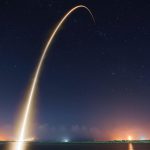Dr Bowen begins his book with Colin Gray’s challenge – “Where is the theory of space power? Where is the Mahan of the final frontier?”. This challenge, made in 1996, could be repeated today and is perhaps one reason why spacepower still sits on the periphery of professional military education and International Relations. This is an extraordinary and unsatisfactory state of affairs given the importance of space-based systems in modern warfare and spacepower in the distribution of power between actors in the international system. It is a state of affairs which this book seeks to correct by offering a new and compelling theory of spacepower. Bowen’s theory is based around seven propositions which form the structure of the book as he takes the reader through each one. The propositions are:
I Space warfare is waged for the command of space.
II Spacepower is uniquely infrastructural and connected to Earth.
III The command of space does not equate to the command of Earth.
IV The command of space manipulates celestial lines of communication.
V Earth orbit is a cosmic coastline suited for strategic manoeuvres.
VI Spacepower exists within a geocentric mindset.
VII Spacepower is dispersed and imposes dispersion on Earth.
Part 1 of the book explains propositions I-IV which moderate existing spacepower theory, which draws in turn on sea power theory and particularly the ideas of Mahan and Corbett. As Bowen explains ‘the works of Alfred Thayer Mahan and Julian Corbett provide an essential foundation for strategic thinking about space because they provide universal concepts regarding the command of a transitory medium’. One example he offers is space control and denial being analogous to the ideas of sea control and denial; for example, being able to deny the use of space by disabling an adversary satellite does not imply space control (being able to use it for yourself) any more than sea denial (e.g. by mining) confers sea control.
However, Bowen critiques the simplistic export of maritime strategic thought into space. He highlights the limitations of the sea power analogy; as he puts it when explaining proposition II, ‘Despite the resonant analogy between commanding the sea with commanding space, Earth orbit must still be considered a unique place that places specific demands on any knowledge base and technical skills of any actor.’ In proposition III, he goes on to dispense with the simplistic notion of space as the ultimate high ground, implying as it does that command of space equates to command of earth. As he puts it ‘as long as human life clings to the landmasses of Earth and the resources that feed civilisation come from Earth, spacepower by itself may struggle to be decisive, no matter the level of preponderance or hegemony in space.’ Nonetheless, Bowen explains in Proposition IV that spacepower does manipulate celestial lines of communication, whether these are physical paths taken by satellites or the data which flows through them. Underpinning all of this is a reminder that spacepower theory cannot be treated in isolation from Clausewitz’s principles of war. War, even war in space, ‘is a socio-political phenomenon composed of the elements of passion, reason and chance…space warfare is the continuation of Terran politics by other means.’ While taking the reader through these first four propositions, Part 1 of the book provides a comprehensive exposition of strategic thought and integrates them into spacepower theory in a nuanced way.
Having established a solid conceptual foundation in Part 1, Bowen introduces his new vision of spacepower in Part 2. It begins with Proposition V: that orbit is a cosmic coastline suited for strategic manoeuvres. Here he points out more limitations of applying bluewater seapower theory to space as ‘Earth orbit is within weapons range of Earth’s surface, space powers can be neighbours on Earth, may also share a cosmic coastline without vast, isolating distances between them, and celestial lines of communications are not the only ones available for strategic actors to use in war’. By imagining space as a hostile coastline shared by continental powers rather than a vast ocean separating sea powers, Bowen makes the book’s most important contribution to spacepower theory. This concept is problematic for Corbett’s ideas given that these were written from the perspective of an island seapower. Instead Bowen proposes that we turn to the continental school of sea power and considers the ideas of Castex, the Jeune École and Gorshkov, integrating their works into his spacepower theory.
Proposition VI, that spacepower exists within a geocentric mindset, is the cultural consequence of this continental seapower analogy. ‘Military astroculture will resemble that of seapower for continental navies and states with land-orientated grand strategies and primary threats’. He suggests that spacepower will struggle in the institutional competition for resources and prestige in the same way that continental navies do. He then follows with an interesting and topical discussion on the institutional changes spacepower has precipitated in major, and some minor militaries. Given the recent creation of US Space Force and the UK’s continued grapples with the institutional challenge of spacepower, this is compelling reading.
In his final proposition, Bowen turns to the ‘so what’ of spacepower and here he argues that ‘the command of space and strategic manoeuvres in orbit influence the way terrestrial military forces may concentrate and disperse to impose and resist terrestrial firepower effects.’ Here concentration does not necessarily mean geographic proximity, but rather a unity of effect which spacepower enables by networking physically distant units and allowing them to concentrate their firepower. ‘The beneficiaries of spacepower can disperse whilst retaining an effect previously gained only by massing forces into large concentration.’ Conversely, ‘the opponents of such a force must disperse, counter spacepower, intercept precision munitions in response, or face annihilation.’ This is the ‘hard edge’ of spacepower and one which has significant consequences for land, naval and air forces.
War in Space concludes by applying the 7 propositions to a hypothetical ‘clash of spacepowers’ between China and the US over Taiwan. This takes the reader through 2 strategies: a ‘space pearl harbour’ and ‘counter-space-in-being’. It wisely makes no prediction on the outcome, but helps the reader to better understand how the propositions integrate with each other and a Terran conflict.
Dr Bowen is a leading spacepower thinker and this book is the culmination of 8 year’s work. It is an impressive and comprehensive study which makes a significant contribution to spacepower theory and will undoubtedly take its place on the essential reading lists of universities and defence academies around the world. The book is aimed at an academic audience and assumes a degree of familiarity with the concepts behind strategic studies and the ideas of key strategic thinkers such as Clausewitz, Mahan and Corbett. It may not therefore be readily accessible to every practitioner. Nonetheless it is required reading for any student of International Relations or Strategic Studies. It is also required reading for any serious practitioner (from any service) who aspires to think clearly about how modern wars will be fought. As Bowen notes in his conclusion, ‘spacepower’s time has come’.
War in Space; Strategy, Spacepower, Geopolitics by Dr Bleddyn E. Bowen was published by Edinburgh University Press in June 2020.

Andy Netherwood
Andy served for 26 years in the RAF with operational tours flying C130 & C17 and staff tours in Strategy, Policy & Plans, Capability Development and on the Directing Staff at the UK Defence Academy. He is now the Air & Space power editor for the Wavell Room. You can follow him on Twitter @AndyNetherwood.





